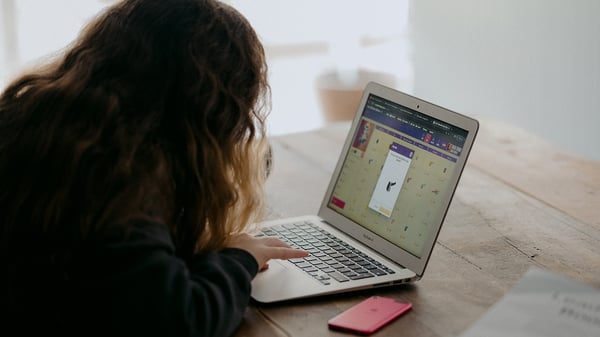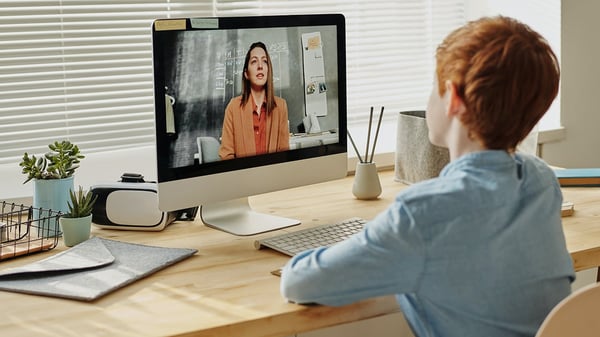There are many reasons, both physical and psychological, that might make it necessary for a student to attend school from home. Some students live in remote locations and cannot travel to school. Some suffer from physical or mental health conditions that confine them to their home.
The reasons why a student might need distance learning may be short-term or long-term. Whatever the reason, remote learning poses challenges for both teachers and students: distractions, the lack of clear start and end times and lack of sufficient technology are just some of them. However, if these challenges are addressed, then remote learning can provide benefits that traditional education does not. It can lead to greater differentiation, flexibility and engagement.
 Photo by Andrea Piacquadio from Pexels.
Photo by Andrea Piacquadio from Pexels.
Navigating some challenges that result from remote learning
- Students need to have the necessary digital tools and knowledge to attend instruction. Disadvantaged students might have the right to receive financial aid to acquire these tools, depending on where they live.
- Students should try to keep to a designated study area during instruction. Not all students will have the option to have one, but if they do it will go a long way toward minimizing distractions.
- A clear timetable for students will help them get organized and stay on schedule. This timetable should include frequent breaks. Students should be encouraged to maintain a routine and make use of tools such as a timer if they need them.
- Time for physical activity and creativity should be included in this schedule.
- Students should be provided with tools that allow them to communicate with each other and with the teacher easily, in order to promote collaboration and address the lack of social interactions with peers.
- Video recordings that introduce and clarify concepts should be made available to students when possible. Teachers can either record their own or use existing YouTube videos. This way, students will be able to rewatch a lesson if they need to.
- Having a good, safe relationship with one’s students is essential. This relationship can be promoted by checking in with the students regularly.
 Photo by Annie Spratt on Unsplash.
Photo by Annie Spratt on Unsplash.
Learning from home using NUITEQ Snowflake
Even if all these challenges are resolved, teachers might still find that remote instruction doesn’t get through to all students. Some students might not show interest in the lessons. Others might struggle to keep up or, on the other end of the spectrum, find lessons too simple. These are problems that teachers face in the classroom as well, but in remote learning situations, where teachers are not physically present to assist students, they are magnified.
One way to tackle this is with the use of Snowflake. Snowflake allows teachers to create fun, engaging activities in a simple, fast way. Through the use of its 16 different lesson activity templates and the ability to use video, images and sound as content, it gives teachers the opportunity to provide multiple means of representation of the educational material in accordance with the Universal Design for Learning guidelines. Using images, for instance, can help students who can’t read acquire knowledge.
Watch this quick-start video to find out how you can start creating lesson activities in Snowflake today!
In Snowflake, teachers can even link a video to their activity and attach external links to other useful resources. Videos can be viewed in advance - several times, if the students need to. This is also particularly useful in a flipped classroom situation, where students review the educational material in advance and then discuss it and analyze it together with their classmates and teacher. By attaching links and videos to an activity, teachers can easily adjust its difficulty level. Students that have progressed further in their learning can be given additional, more challenging activities whereas students that need additional support can be provided with it. This way, teachers can personalize learning to a degree that is much harder to do by traditional means.
 Photo by Julia M Cameron from Pexels.
Photo by Julia M Cameron from Pexels.
Lesson activities and lists as homework
Lesson activities can be sent to students either instantly or at a scheduled time as homework, to help them reinforce concepts and skills that they have learned. They can also be sent as assessments to check whether they have learned what was taught.
When students work with a lesson activity created with a gradable template like Quiz, their answers are automatically corrected. This simplifies teachers’ work and saves them time, since they don’t have to grade these activities manually.
Teachers can create lists containing lesson activities and PDF files. By making lists, teachers can organize their work according to different parameters such as subject or grade. These lists can also be sent to students. This means that a teacher can create different lists for different students to differentiate learning according to interests and abilities, and provide extensions and scaffolding to those students who need it.
Reviewing and monitoring students’ progress
Snowflake gives you the opportunity to monitor your students’ progress. When teachers send individual activities or lists of lesson activities to their students, they can immediately see how it has gone for them once they have submitted their answers. In the case of assessment activities, teachers can even see which questions students got right and which they got wrong. Teachers can then easily send feedback to their students; this can, for example, be used for formative assessment purposes.
 Photo by Marcus Aurelius from Pexels.
Photo by Marcus Aurelius from Pexels.
Remote learning is not without its challenges. However, with the right infrastructure in place, it can be an important part of a democratic society that strives to provide all its members with the education they have a right to. Students who cannot be physically present in school are given the means to succeed just as well as their peers who attend classes in place. Snowflake is a valuable tool in this cause, which simplifies teachers’ work and activates students.

 3-in-1 Mic
3-in-1 Mic



